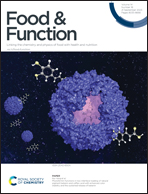Identification of dietary components in association with abdominal aortic calcification†
Abstract
The precise impact of dietary components on vascular health remains incompletely understood. To identify the dietary components and their associations with abdominal aortic calcification (AAC), the data from NHANES was employed in this cross-sectional study. The LASSO method and logistic regression were utilized to identify dietary components that exhibited the strongest association with AAC. Grouped WQS regression analysis was employed to evaluate the combined effects of dietary components on AAC. Furthermore, principal component analysis was employed to identify the primary dietary patterns in the study population. The present analysis included 1862 participants, from whom information on 35 dietary macro- and micronutrient components was obtained through 24-hour dietary recall interviews. The assessment of AAC was performed utilizing dual-energy X-ray absorptiometry. The LASSO method identified 10 dietary components that were associated with AAC. Total protein, total fiber, vitamin A, and β-cryptoxanthin exhibited a negative association with AAC. Compared to the first quartile, the adjusted odds ratios (95% CIs) for the highest quartile were 0.59 (0.38, 0.93), 0.63 (0.42, 0.93), 0.59 (0.41, 0.84), and 0.68 (0.48, 0.94), respectively. Grouped WQS regression demonstrated a positive association between the lipid group and AAC (aOR: 1.29; 95% CI: 1.12, 1.50), while the proteins and phytochemical group exhibited a negative association with AAC (aOR: 0.69; 95% CI: 0.58, 0.82). For the dietary pattern analysis, high adherence to the plant-based pattern (aOR: 0.62; 95% CI: 0.44, 0.88) was associated with a lower risk of AAC, whereas the caffeine and theobromine pattern (aOR: 1.73; 95% CI: 1.25, 2.41) was associated with a higher risk of AAC. The findings of this study indicate that adopting a dietary pattern characterized by high levels of protein and plant-based foods, as well as reduced levels of fat, may offers potential advantages for the prevention of AAC.


 Please wait while we load your content...
Please wait while we load your content...